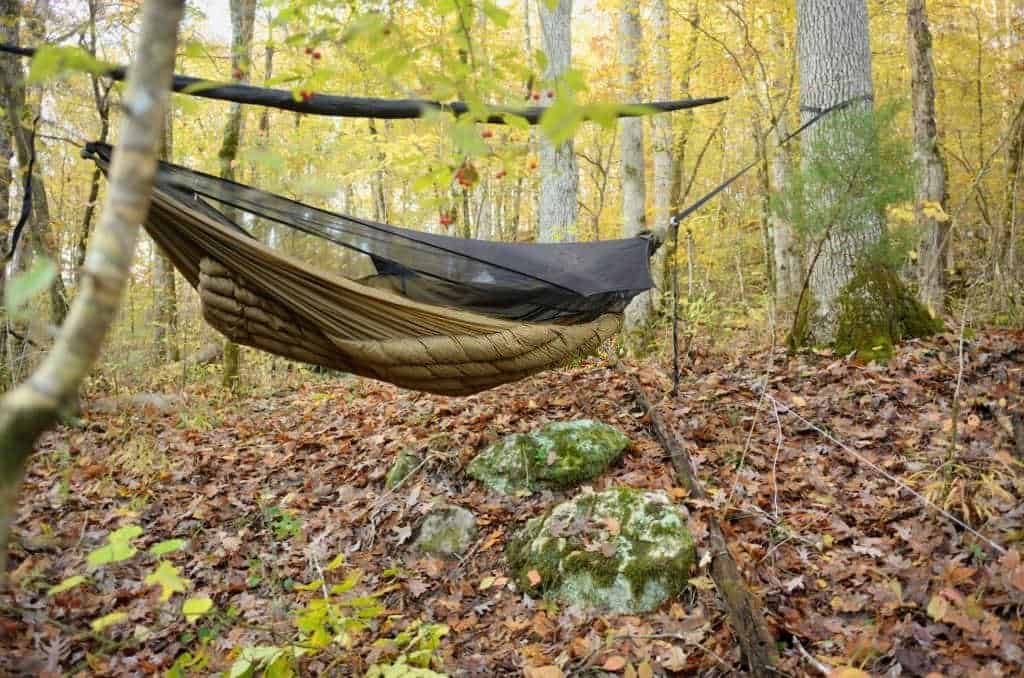You’re camping out and can’t decide between a hammock sleeping pad vs underquilt.
Which one’s a better value overall?
Some people would rather skip either one and sleep in their hammock without an insulation method at all. If you’re sleeping outdoors in the sweltering night time heat, you may do away with just a plain hammock.
But with the conditions ever-changing in the wilderness, you want to make sure you’re warm and cozy. Sleeping in the cold is no fun… If you can even get any sleep, to start with!
So if you had to choose between buying an underquilt and a sleeping pad, check out this side-by-side comparison of these two options. Know what to expect from each and which one’s right for your unique needs. Let’s jump right in!
Contents
Hammock Sleeping Pad Vs Underquilt – Why Do You Need One?
Backpackers rely on their trusty hammocks for portability and convenience.
It’s so easy to set it up once you have found your camping spot. Even if the terrain is uneven, you can sleep in your preferred spot, as long as there are tree branches for you to hang your hammock.
And once you’re done, just untie the strings, fold it down and pack it up. You’re good to go in no time.
Hammocks are perfect for your afternoon siestas or for a night time snooze. Just add in your choice of insulation, and you should be good to go – all warm and cozy in your suspended outdoor “bed”.
With the unpredictable weather in the woods, and if you simply want softer back support when you lay in your hammock, it’s good to have some kind of an insulation method.
Speaking of insulation, you have two common options to choose from:
A sleeping pad or an underquilt.
Both of these do the job of keeping you comfortable in your hammock. But then again, there are some disadvantages to each you need to know about. These small differences can help you decide which one is best for you and an overall great deal for your money.
Read More: Is It Warmer To Sleep With Clothes On Or Off? How to Have a Cozier Sleep Experience
Sleeping Pad Pros and Cons:
A sleeping pad is usually made of foam or inflatable material. It fits perfectly in your hammock while other versions are more on the shorter side or square design.
Most sleeping pads are thin, yet they provide minimal cushion unlike when you sleep in a bare hammock.
PROS:
- More versatile to use for an overnight camping adventure.
- Budget-friendly and fairly inexpensive
- Lightweight and easier to bring
- Thin and does not take up too much room in your backpack
CONS:
- Has a tendency to shift each time you move
- Most sleeping pads are short and narrow
- Does not offer much warmth
- Holds condensation and can get slightly soggy in the morning
Overall, if you want a cheaper, lighter, and more portable option for insulation to put in your hammock, a sleeping pad is a smart choice. It ticks all the boxes when it comes to convenience and efficiency.
However, do take note that it is not super cozy when it’s a little on the narrow and short side. It also shifts as you toss and turn in your hammock, which can be a bit annoying for some people. Plus, with the issue of condensation, you wouldn’t want to wake in a slightly damp pad each morning.
There are some hacks you can try to minimize condensation issues. Here’s a video you may want to check out for ideas:
Underquilt Pros and Cons:
Thicker and warmer, an underquilt offers you a cozy cushion in your hammock as you sleep. It is basically a blanket that functions quite like a sleeping bag. This soft layer provides good insulation to keep your body warm. The result – a good night’s sleep in the outdoors!
PROS:
- Not as heavy despite the thicker quality
- Provides more warmth and comfort
- Perfect to use in a colder climate
- Softer and more cushy than a sleeping pad
CONS:
- A bit bulky and takes up plenty of space in your bag
- Not very easy to attach to your hammock
- More expensive than sleeping pads
If you want to have that familiar cozy feel you get when you’re in your bed back home, then an underquilt can do it for you. It’s thicker, softer, and warmer, providing your body better insulation from the cold weather.
Do keep in mind, though, that it can be a challenge to pack an underquilt in your bag. Unless you buy one of those ultra-light ones, be prepared to bring a bigger pack for your trip. It’s also pricier than a sleeping pad because of the extra warmth and comfort you get.
Not too sure how to attach an underquilt in your hammock? Check out this helpful guide to get you set up fast :
Are There Alternatives to an Underquilt or Sleeping Pad?
Let’s say you’d rather not buy either one of those.
Yet, you want some kind of support on your body when you sleep in your hammock. What are your options?
Some people use just a simple blanket while others consider using their car’s sunshade. Either one may be able to give you some insulation but not by much.
Quite frankly, blankets can be just as thick and bulky as a pad or underquilt. And they don’t really give you the same cozy feeling as you sleep.
On the other hand, sunshades are rigid but not at all snug and comfortable. Once the temperature dips, you may grumble and wish you’ve got a cozy underquilt or sleeping pad instead of a thin and hard sunshade…
So, in the end, it all comes down to your budget and priority. If you want to stay warm and comfortable, an underquilt is for you. But if you prefer a cheaper option, a sleeping pad is not too bad of a choice at all.




